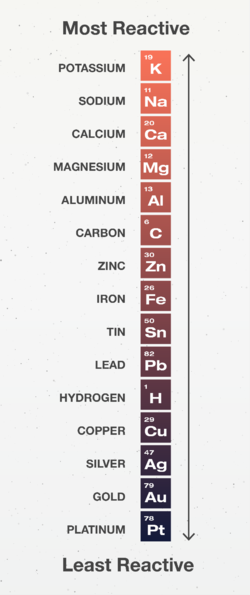Reactivity Series
Contents
Key Stage 3
Meaning
The Reactivity Series is a list of elements in order of their reactivity.
About The Reactivity Series
- The Reactivity Series is used to predict the outcome of Displacement Reactions. Elements higher on the reactivity series will displace those lower down on the reactivity series.
- Carbon and Hydrogen are important in the Reactivity Series as they can indicate how a metal can be extracted from a mineral.
- Elements below Hydrogen are found Native which means the metal element can be found not as part of a compound.
- Elements above Hydrogen but below Carbon are found in minerals, which are metal compounds, so they need to be extracted by using Carbon to displace the metal from the compound.
- Elements above Carbon are found in minerals but they cannot be extracted with Carbon because Carbon is less reactive than those metals so we use electrolysis to extract them.
Key Stage 4
Meaning
The Reactivity Series is a list of metal elements in order of how easily they can lose electrons to form positive ions.
About The Reactivity Series
- The reactivity of a metal is determined by how easily it can lose electrons to form positive ions. When metals are placed in order of their reactivity it is called the Reactivity Series.
- The more easily a metal can lose electrons to become a metal ion the more reactive that metal is.
- The Reactivity Series can be found experimentally by observing the reactions between metals and either water or acid.
- Metal elements which can lose electrons more easily than Hydrogen is able to lose its electron will react with water and with acids.
- The rate of reaction and the energy released during a reaction is directly related to the metal's reactivity. The faster the reaction and the more energy released during that reaction the greater the reactivity of that metal element.
References
AQA
- Reactivity series of metals, pages 200-1, GCSE Combined Science Trilogy 1, Hodder, AQA
- Reactivity series of metals, pages 98-9, GCSE Chemistry, Hodder, AQA
- Reactivity series, pages 130, 131, GCSE Combined Science; The Revision Guide, CGP, AQA
- Reactivity series, pages 130-1, 134-5, 165, 182-3, GCSE Chemistry; Student Book, Collins, AQA
- Reactivity series, pages 133, 138, GCSE Combined Science Trilogy; Chemistry, CGP, AQA
- Reactivity series, pages 158, 163, GCSE Chemistry, CGP, AQA
- Reactivity series, pages 55, 56, GCSE Chemistry; The Revision Guide, CGP, AQA
- Reactivity series, pages 84-89, 120-121, GCSE Chemistry; Third Edition, Oxford University Press, AQA
Edexcel
- Reactivity series, pages 114, 117, GCSE Combined Science; The Revision Guide, CGP, Edexcel
- Reactivity series, pages 148, 155, GCSE Chemistry, CGP, Edexcel
- Reactivity series, pages 52, 55, GCSE Chemistry; The Revision Guide, CGP, Edexcel
- Reactivity series, pages 66, 86, GCSE Chemistry, Pearson, Edexcel
